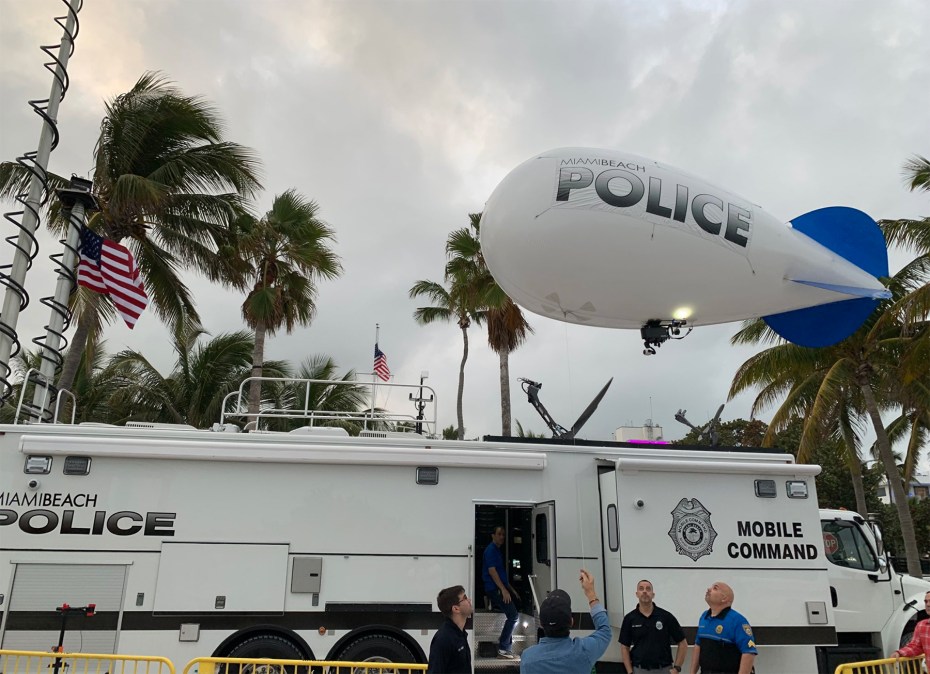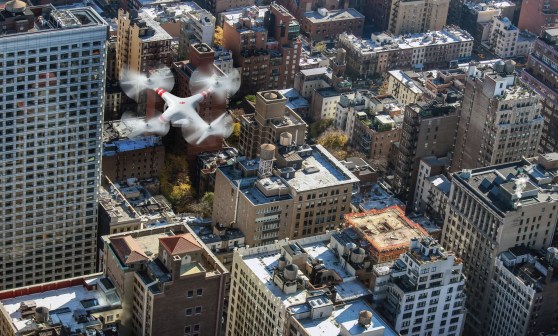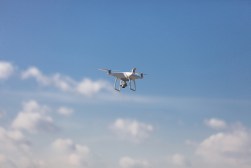Miami Beach PD circumvents ban on drone surveillance with a blimp

Can’t use a drone? What about a blimp?
Miami Beach Police Department circumvented a 2015 ban on police drone surveillance when it monitored a crowded Orange Bowl celebration event last month using a small, helium-filled blimp, called a “tethered aerostat.”
Essentially a camera-equipped balloon at the end of a leash, the aerostat was purchased by MBPD this winter to assist in monitoring the safety of large crowd events in Miami Beach and did so when it surveilled the 15,000 attendees at the Capital One Beach Bash on Dec. 28.
In a letter sent to the city’s commission, City Manager Jimmy Morales admitted that MBPD acquired the tethered aerostat as a calculated workaround to the Freedom from Unwanted Surveillance Act, which restricts police use of drones.
“Due to the legal restrictions placed on police departments under Florida law and because of limited battery life and flight time, Unmanned Aerial Systems is not a current option for the Miami Beach Police Department to monitor crowds from the air at large gatherings and major events,” Morales wrote. “As crowds at major events here in the city have increased in size over the years, and given the emergence of new threats of terrorism seen around the world at such large gatherings, the department sought to acquire a new technological solution for aerial monitoring.”
Morales said that the tethered aerostat “provided an ideal vantage point in an unobtrusive manner, with a sleek, yet friendly look.”
However, despite claiming that the blimp-like surveillance tool is a legal alternative to drones, concerns have now risen over the constitutionality of aerial surveillance. Jay Stanley, a senior policy analyst with the American Civil Liberties Union, said in an op-ed that although Americans have become increasingly accepting of video surveillance, aerial surveillance has huge opposition.
Unlike drones, tethered aerostats do not require FAA authorization to enter public airspace because of their tether. Additionally, there are some operational differences between the two devices — most notably, drones have superior agility and navigation capabilities. However, both drones and aerostats are used to achieve similar outcomes.
Balloons and blimps have had a long-standing history with military reconnaissance. First introduced in 1861, Thaddeus Lowe demonstrated balloon reconnaissance to President Abe Lincoln who was so impressed he established the now defunct Balloon Corps and used the technology to monitor Confederate troop movement in the Civil War. Blimps were also extensively used in both world wars for both offensive and defensive missions. Similarly, drones are now used prolifically in war zones for surveillance and strikes, although balloons and blimps are still seen as cost-effective alternatives to high-tech and costly unmanned aviation systems.
The introduction of military technology to civilian enterprises has sparked a national debate over unmanned aviation surveillance, concerns with citizens’ privacy rights, and constitutionality of domestic aerial surveillance. A paper out of the William S. Boyd School of Law at the University of Nevada, Las Vegas, weighs the pros and cons of police-operated UAVs and recognizes there is both potential benefit for law enforcement and potential to erode public privacy.
Under the Fourth Amendment of the U.S. Constitution, private citizens are protected from “unreasonable searches and seizures” by the government. John Villasenor, a senior fellow in Governance Studies and the Center for Technology Innovation at Brookings Institute, a think tank in Washington D.C., said in an op-ed on drones and the Fourth Amendment, that there is no reason to believe that the law’s power, which has protected citizens for over 200 years of technological advancements, will lose its potency.
In three 1980s-era legal proceedings, the Supreme Court ruled in favor of warrantless observations from unmanned aircraft, and a review of the opinions in these and other cases revealed that naked-eye observations were not seen as Fourth Amendment violations. However, in a 2001 Supreme Court decisions, ground-based thermal imaging used to see inside of a home was ruled an unreasonable search, suggesting that drones or balloons equipped with visual enhancing technology may be deemed unconstitutional. In his opinion for Kyllo v. United States, Justice Antonin Scalia expressed concern that allowing the government to freely collect any information from private property would place citizens “at the mercy of advancing technology — including imaging technology that could discern all human activity in the home.”
Although much is uncertain over the legality of drone, and now balloon, surveillance, legal precedent suggests that the Fourth Amendment will remain reasonably protective. In the case of Miami Beach, Morales said, “the department will continue to experiment and develop skills and experience with this device in the days ahead in an ongoing effort to improve public safety.”






